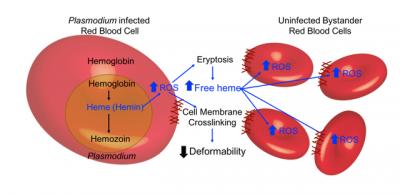

Red blood cells become less deformable as they undergo heme-induced oxidative stress caused by malaria parasites.
Credit: Kerryn Matthews, University of British Columbia
One way malaria wreaks havoc on the body is by causing excessive amounts of toxic heme, the non-protein component of hemoglobin, to accumulate in the bloodstream. Among other things, this free heme induces oxidative stress in red blood cells (RBCs), leading to their rigidification, destruction and subsequent removal from circulation — a condition known as hemolytic anemia.
In their study, which appeared in Integrative Biology, the UBC investigators found that RBCs become increasingly rigid in direct correlation with the concentration of oxidized heme, or hemin, in the blood. Since hemin is difficult to measure directly — it tends to insert itself into cell membranes — monitoring changes in RBC deformability can therefore serve as a reliable alternative marker of hemin-induced oxidative stress and malaria progression.
“Because this method is mechanical, it's well suited for use in resource-poor countries, where the vast majority of malaria transmission takes place,” says Kerryn Matthews, a postdoctoral fellow at UBC and the study's lead author. “Other methods of analyzing malaria severity require training or expensive equipment or chemicals that are not readily available in developing nations.”
To measure RBC deformability quickly and sensitively, the UBC investigators developed the “multiplex fluidic plunger”: a simple microfluidic device consisting of a parallel array of 34 funnel-shaped, micro-sized channels across which uniform, carefully controlled pressures can be simultaneously applied.
By loading the plunger with whole blood, docking an RBC at each channel and applying progressively higher pressures until the RBCs are squeezed through — or not, if an RBC is too stiff — one is able to determine the rigidity, or cortical tensions, of many cells at once and build an RBC deformability profile in minutes.
“The device can be easily integrated with a conventional microscope coupled with a digital camera,” says Matthews. “And the accompanying software, which does all the analysis and records the pressures, is simple to use.”
In addition to indicating the status of a malaria infection, RBC deformability information would be valuable in the development of antimalarial drugs, as well as in illuminating the mechanism by which RBCs are sequestered from circulation and destroyed.
Healthy RBCs are extremely flexible, capable of squeezing through spaces — the tiniest blood vessels, for example, or the channels between cells — that are just fractions of their original size. By rendering them less deformable, malaria parasites impair blood flow and ultimately cause organ failure and possibly death.
According to the World Health Organization, malaria killed an estimated 429,000 people and caused approximately 212 million clinical episodes in 2015. It primarily affects children and pregnant women in poor tropical and subtropical countries.












